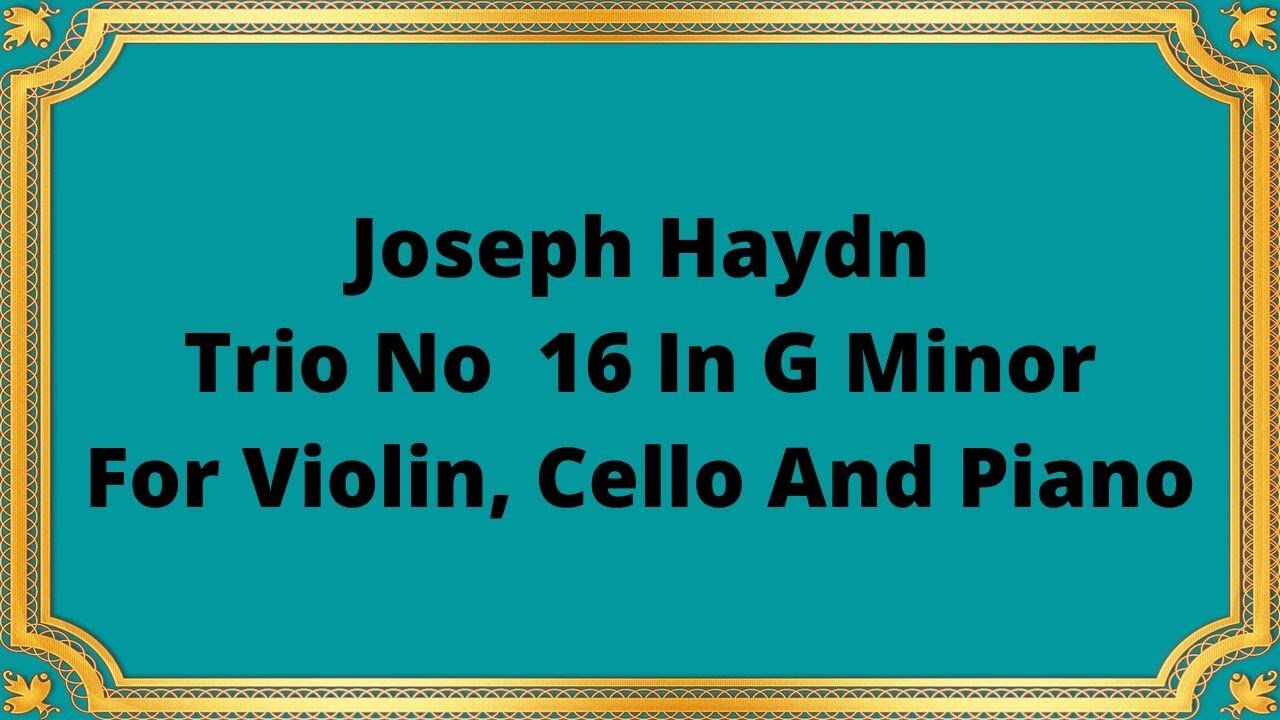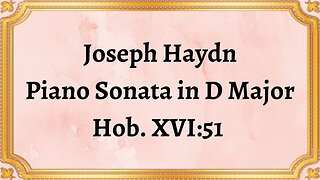Premium Only Content

Joseph Haydn Trio No 16 In G Minor For Violin, Cello And Piano
#classicalmusic #JosephHaydn #TrioNo16 #GMinor #Violin #Cello #Piano #MusicalComposition #HaydnTrio #ClassicalComposers #MusicHistory #ClassicalEnsemble #ChamberMusic #HaydnInfluence #HaydnLegacy #MusicPerformance #HaydnTrioNo16
Publication date 1955
JEAN FOURNIER, Vion
ANTONIO JANIGRO, celo
PAUL BADURA-SKODA, Piano
The world of classical music is adorned with countless masterpieces, each holding its unique charm and significance. Among these treasures is Joseph Haydn's Trio No. 16 in G Minor for Violin, Cello, and Piano. Composed during the late 18th century, this piece showcases Haydn's exceptional talent and artistry.
Joseph Haydn, an Austrian composer widely regarded as the "Father of the Symphony," wrote Trio No. 16 in G Minor during his later years. This period, known as the Classical era, witnessed a shift in musical style from the elaborate Baroque to a more balanced and structured approach. Haydn, along with his contemporaries Mozart and Beethoven, played a pivotal role in shaping this new musical landscape.
Trio No. 16 in G Minor is a prime example of Haydn's expertise in chamber music. It consists of four movements – Allegro moderato, Menuetto, Adagio, and Finale: Presto. The opening Allegro moderato sets the tone with its dramatic and melancholic melodies, showcasing Haydn's ability to evoke emotions through music. The Menuetto, a lively and rhythmic dance-like movement, provides a refreshing contrast. The Adagio is a serene and introspective movement, allowing the listener to experience moments of tranquility. The Finale: Presto concludes the piece with its lively and energetic character, leaving a lasting impression.
Haydn's Trio No. 16 demonstrates a remarkable balance between the three instruments – the violin, cello, and piano. Each instrument has its distinct voice and plays an integral role in developing the musical narrative. The violin takes on the melodic lead, while the cello provides a rich and grounding bassline. The piano acts as both a harmonic support and a soloistic instrument, showcasing Haydn's mastery of writing for the keyboard.
Haydn's Trio No. 16 in G Minor has stood the test of time, continuing to captivate audiences and musicians alike. Its emotional depth, technical brilliance, and impeccable compositional structure have solidified its place as a cornerstone of the chamber music repertoire. This composition serves as a testament to Haydn's genius and his contribution to the development of classical music.
Conclusion:
Joseph Haydn's Trio No. 16 in G Minor for Violin, Cello, and Piano exemplifies the brilliance and artistry of the composer. With its rich musical tapestry, emotional range, and exquisite craftsmanship, this piece continues to inspire and enchant listeners to this day. Its historical significance and enduring legacy make it a true masterpiece of classical chamber music, deserving of recognition and appreciation for generations to come.
You have the opportunity to support the channel:
https://destream.net/live/RadSiarAl/donate
https://www.buymeacoffee.com/6355radsiaral
-
 6:07
6:07
Classical music_Music Inspiration
24 days agoJoseph Haydn Piano Sonata in D Major, Hob. XVI:51
701 -
 LIVE
LIVE
Steven Crowder
2 hours ago🔴 WINNING: Why Trump Has John Oliver & All of Europe Freaking Out
62,505 watching -
 LIVE
LIVE
Bannons War Room
16 hours agoWarRoom Live
19,131 watching -
 LIVE
LIVE
Wendy Bell Radio
5 hours agoCHECKMATE
12,719 watching -
 LIVE
LIVE
VSiNLive
46 minutes agoA Numbers Game with Gill Alexander | Hour 1
120 watching -
 LIVE
LIVE
Matt Kohrs
10 hours agoPumping To New Highs, Memecoin Mania & The Week Ahead || The MK Show
1,288 watching -
 42:05
42:05
BonginoReport
4 hours agoPothole Pete Blames Plane Crash in Canada on Trump (Ep.142) - 02/18/2025
64.2K129 -
 1:13:40
1:13:40
Graham Allen
3 hours agoDOGE Is Going After The IRS!! Mass Firing Soon!! + ANOTHER Plane Crash! We Are Not Safe…
35.5K11 -

Randi Hipper
59 minutes agoArgentina's Meme Coin Disaster: Inside the LIBRA Crash
2.93K1 -
 DVR
DVR
Chicks On The Right
4 hours agoCrazy plane crash, crazy lib protests, and Deborah Birx can suck it
38.7K5